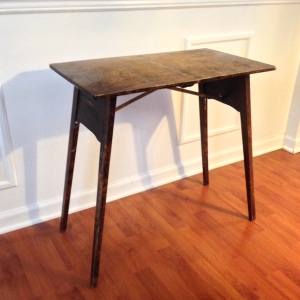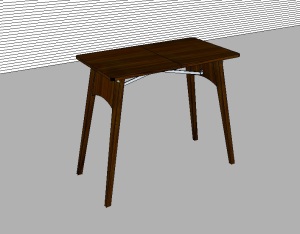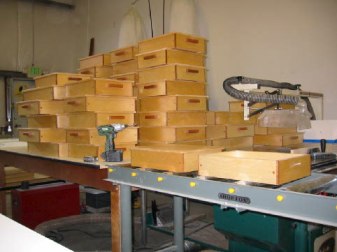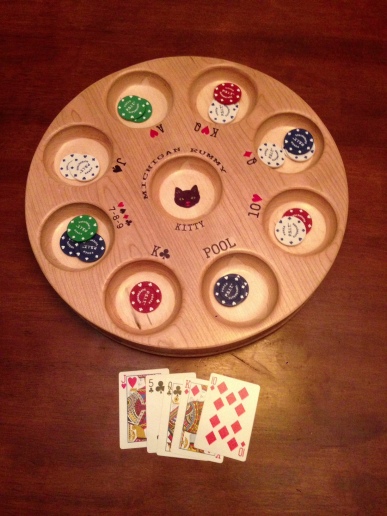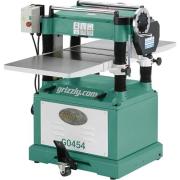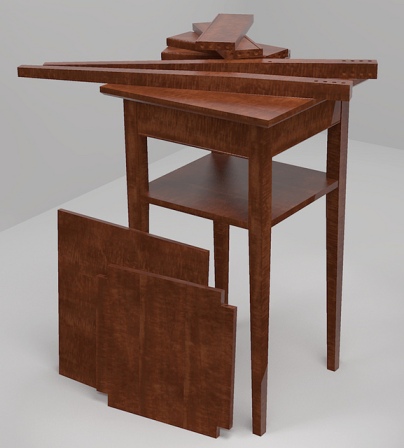Tools aren’t just in the shop these days, but on the computer as well. I think I spend about 1 hour on the computer designing for every 10 hours in the shop, designing either future products I’ld like to offer, or ones that current clients are requesting. I use a free product called SketchUp. SketchUp is a free 3D modeling design program for woodworkers (and architects, interior designs, mechanical engineers, etc), and is available for Mac and Windows machines. I need to have accurate drawings so I make less mistakes in the shop, and can create a better product. I enjoy the advantage of being able to create a custom project for a client, and almost build it before I build it, on the computer. That’s a huge selling point to a potential client. As someone that wants to sell something (maybe that’s you!) you need to remove any barriers to that person saying “Yes” to a sale. Not being able to visualize the product is one of those things. “Yeah, I can build you a cherry desk with two drawers” isn’t good enough; it’s too…sketchy. I can build you this cherry desk (showing the potential client a rendering) is a much better, and makes the client feel more secure. Also, learning SU (SketchUp), fosters creativity; you can mix and match woods, change any part easily, go crazy. More accuracy, better chances at a sale, fostering creativity – this is why I state You Need to Learn SketchUp!
Learning SketchUp
The hardest part of SketcUp is learning to use it. I gave up once trying to learn it, but thankfully came back to it, and am quite proficient now. I reached out to experts like Dave Richards who has a free blog you can use at Fine Woodworking, titled Design.Click.Build. Dave has also put out a DVD and book for beginners, which you can find here. There’s also a “for dummies” book found here. And there are many videos on YouTube. Is it difficult to learn? I’d have to say yes. Is it WORTH IT to learn? A definite yes.
While in SU, you see a pretty crude model, but certainly good enough to work with. This is the model you’d work with to get where you want to be on the project. Let me give you a real world example…
A friend of mine had this table – it’s probably made in the 30s. It’s an interesting table in that it folds up, when you pull up at the center joint. There was just something about it that struck me. Here’s a pic of the actual table.
Any way, I asked him if I could borrow it to make drawings – and so I went to work recreating it in SU. I took all the measurements, including the hardware, and the working model drawing came out like this. As you can see at this point, there is already a strong resemblance to the actual table. The change I made was using walnut as a texture, rather than the maple (I believe) that the original was made of. At this point, if I wanted to go ahead and build it, I would “explode” the drawing – moving the separate pieces apart and putting in ruler measurements for each piece, printing out the screen shots of the pieces, and going down to the shop to build it.
But let’s say that I’ve come up with this table on my own for a client, and wanted to present the idea to the client in the best possible light. I probably wouldn’t send the working SU model, but rather would render the project. What is a rendering? A rendering engine (program) takes a file from a CAD (computer aided design) program – in our case, SU – and “renders” a photo that looks realistic. Some CAD programs can do this from within itself, but many rely on external, third-party programs to accomplish this. I use Kerkythea (care-ka-thea) for rendering from SU.
So why would you want to go through all this trouble to render? Other than looking cool, what’s the benefit to a woodworker? Well, for one thing, it’s really not all that much trouble, and secondly, you get a much better idea of what the end product will look like – far better then the rather cartoonish rendering that SU shows you. More importantly, if you do woodworking professionally, you can show a potential client a piece that is already “built” and change woods, dimensions and scales easily. Make the mistakes in the virtual world before making big mistakes in the shop.
If you are already pretty proficient at SU – no mean feat – then you are ready for Kerkythea – it’s much easier to use then SU. It’s also free, like SU; you can get it here. I won’t rehash how to install Kerkythea – they explain it.
SketchUp & Kerkythea = Awesomeness
If you use SketchUp for woodworking, and you really enjoy the way it helps you in the shop, you might want to take it to the next level, and get into photorealistic renderings such as Kerkythea; it’s a great tool to put the finishing touches on design idea, and getting that client to commit!
